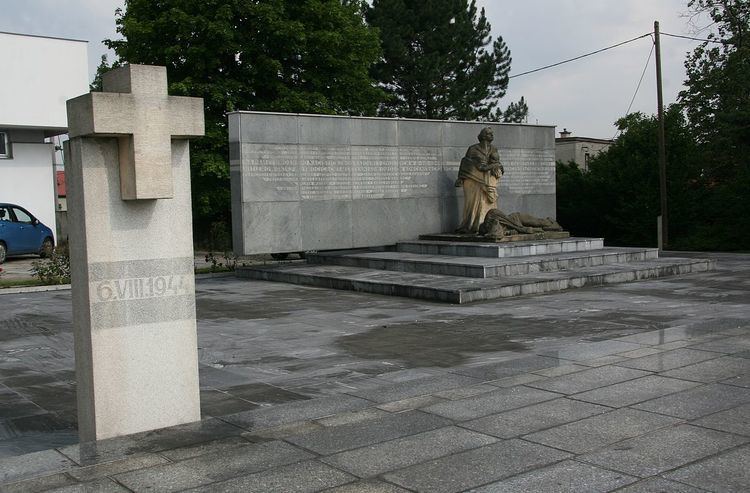Local time Tuesday 7:01 AM | ||
 | ||
Weather 6°C, Wind NE at 10 km/h, 94% Humidity | ||
Životice (Polish: Żywocice , German: Zywotitz, formerly Ziwotitz) is a village in Karviná District, Moravian-Silesian Region, Czech Republic. It was a separate municipality but after the expansion of the city of Havířov created in 1955 it became administratively a part of this city in 1960. It has a population of 1,182 (2010). It lies in the historical region of Cieszyn Silesia.
Contents
Map of %C5%BDivotice, 736 01 Hav%C3%AD%C5%99ov, Czechia
The name is patronymic in origin derived from personal name Żywot.
History
The village was first mentioned in a written document in 1450 as Ziboticze. Politically it belonged then to the Duchy of Teschen, a fee of the Kingdom of Bohemia, which after 1526 became part of the Habsburg Monarchy.
After Revolutions of 1848 in the Austrian Empire a modern municipal division was introduced in the re-established Austrian Silesia. The village as a municipality was subscribed to the political and legal district of Cieszyn. According to the censuses conducted in 1880, 1890, 1900 and 1910 the population of the municipality dropped from 383 in 1880 to 606 in 1910 with the majority being native Polish-speakers (growing from 97.1% in 1880 to 99.3% in 1910) accompanied by a small German-speaking minority (at most 12 or 2.6% in 1900) Czech-speaking (at most 6 or 1.6% in 1880). In terms of religion in 1910 the majority were Protestants (55.5%), followed by Roman Catholics (43.3%) and Jews (8 or 1.2%). The village was also traditionally inhabited by Silesian Lachs, speaking Cieszyn Silesian dialect.
After World War I, fall of Austria-Hungary, Polish–Czechoslovak War and the division of Cieszyn Silesia in 1920, it became a part of Czechoslovakia. Following the Munich Agreement, in October 1938 together with the Zaolzie region it was annexed by Poland, administratively adjoined to Cieszyn County of Silesian Voivodeship. It was then annexed by Nazi Germany at the beginning of World War II. After the war it was restored to Czechoslovakia.
Tragedy
It is well known for the most notorious Nazi war crime of World War II in the Zaolzie area - the Żywocice tragedy. On 6 August 1944, 36 residents of Zivotice and neighbouring villages were shot dead. This number makes it the largest liquidation operation within Těšin Silesia during World War II. The Životice operation thus made suite to such retaliation measures as the annihilation of Lidice and Ležáky. Životice was nicknamed "the Silesian Lidice" when the war was over.
The background for the massacre occurred from August 4 to 5 when the members of a locally operating Polish resistance unit of Armia Krajowa under the command of J. Kamiński killed two officers of the Teschen command of the Gestapo and their driver (who died later during the transfer to Teschen). The innkeeper and a resistance fighter were also killed. The search for the guerilla members was fruitless, and thus, the Gestapo decided to retaliate against the village residents.
In the early hours of Sunday 6 August, Životice was surrounded by the German Army and the Landwache. Those who refused to register as ethnic Germans and to enter the "Volksliste" (the German ethnic register) were targeted against and had already been marked through documentation. The Landwache and Gestapo officers from Teschen and Katowitz combed the village, dragged residents out of their houses and executed them in the nape close to their homes. Some took their chances and tried to escape, but were shot on site.
In addition to local residents, a certain number of people were murdered while passing through the village, these being mostly coal miners on their way back from their night shift, who failed to produce their Volksliste document. The bloody operation counted thirty-six victims. Of these twenty-seven were ethnic Poles, eight Czechs, one was registered as "Volksdeutscher" class three. Twenty-four victims were residents of Životice, six were residents of Horní Suchá, four from Dolní Bludovice, one from Dolní Suchá and one from Dolní Těrlicko. The youngest victim was sixteen, the oldest sixty. When the massacre was over, the corpses were loaded to trucks and carried to the old Jewish cemetery in Orlová, where they were dumped in a commomn grave. The German authorities then entered cardiac insufficiency and cardiac infarcts as the cause of death in the death register. The principal offenders were never tried or punished.
The liquidation operation was headed by Q. Magwitz, the commander of the Teschen headquarters of Gestapo, and targeted innocent victims, never involved in the guerilla operation. Their only guilt was in their opposition to the German assimilation program, preserving their Polish or Czech identity. The corpses were transferred from Orlová to Životice when the war was over. On 25 September 1949, a memorial by Franciszek Świder, a Karviná-based sculptor, was unveiled to commemorate the Životice victims. In 1984, a new building was opened next to the memorial to accommodate the exhibition Occupation and Resistance Movement in Cieszyn Silesia 1938-1944. The memorial is dedicated to all victims of German occupation, commemorating the suffering of local residents. This massacre is known as Tragedia Żywocicka in Polish or Životická tragédie in Czech.
